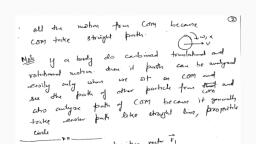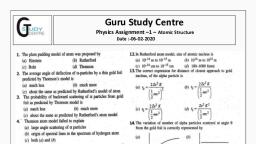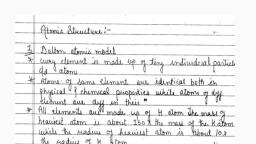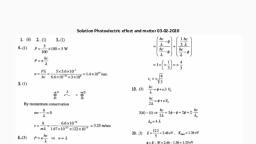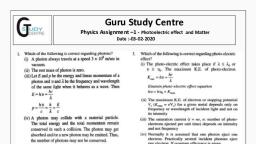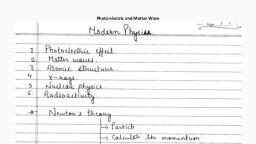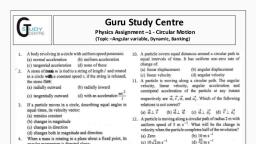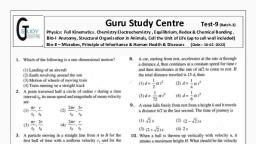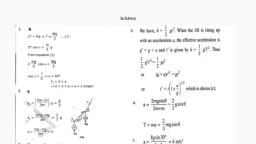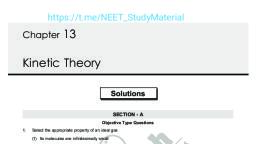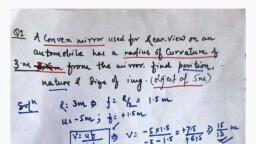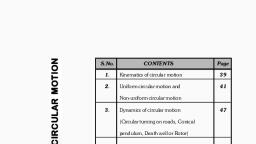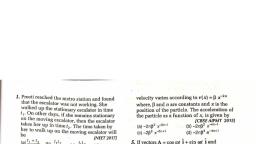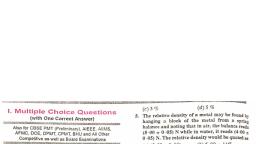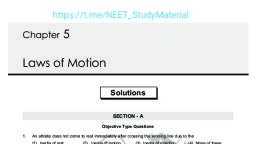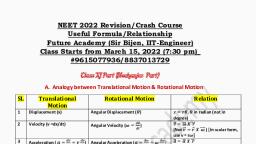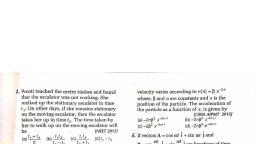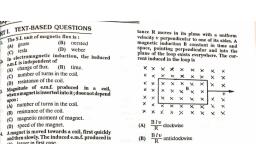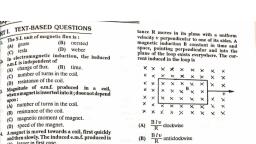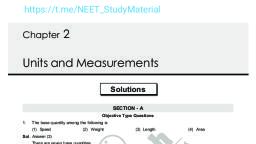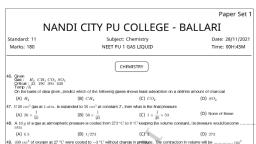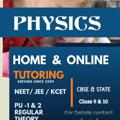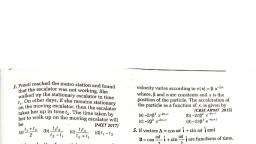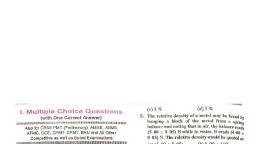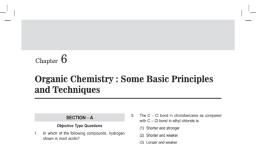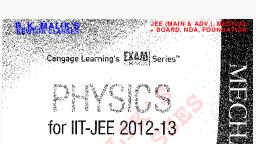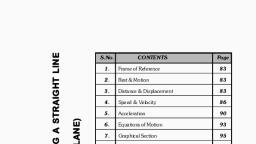Page 2 :
13..(3) Let the first ball reaches the ground after time 1, the, second ball will take time (t-2)., , W0= S91? 1=4s, Let u: initial velocity of the second ball, 80=u(t-2)+ 3-2?, , =u(4-2)+ | 104-27, =2u+20, u=30 ms, 14,(2) Let the regular interval is . When the third drop is about, to fall, the first drop strikes the ground. First drop has fallen, for time: 2r, , “gt, 2 drop has fallen for time: t t, st " | 2 :, Man $= 59 sw fone |, 1° 4 8, > ~greae ths, , 2™ drop: h= se =125m, , The distance of the second drop above the ground is, §-1.25=3.75 m., 15. .(3), 16..(4) O: origin, Oto A: displacement =— 60 m, h= wiser, , -60=201-5e, P-41-12=0, (t-6) (t+2)=0, t=65, (i) is correct, veu-gt, = 20-10 x6=-40 mis, (ii) is correct, After 5 s, displacement,, , = ut—+g 2 =20x5-1x10x5?, 2 2, , = 100-125=-25m, ~ve sign, i.e., ball is below O by 25 m, hence distance of ball, above the ground is, 60 — 25 = 35 m, (iii) is correct, Maximum height of ball above O, 0 = (20)? -2.x 10 x hy => hg = 20 m, , , , 17. (2) ge, , 18., , , , Ball 1:—h= ux9-F20F, , Ball2:h= ux te x(a?, , Solving, h = 180 m, dy c, , (", | od, , OWA: h= ut, ~fen (i), , eng---s", , Oto B: h= ut, ~an (i), Solving u= £, igu= 2 ith), 1, he ehh, OR, , how -Zer, , gh —2ut+2h=0, , Sum of roots, f, +h) = (=), , &, => ua 2(t+t, u 2 1), Rect tae, , 1, => h= zehk, 19.. (1)
Page 3 :
20. (2) A to B: 7 =2¢x5= 100, BtoC:0=v-2axl — y=04yA, a=50 m/s?, , , , ,, v=0, 21..(3) O to A (accelerated motion), , ay | ty, su=0 |, °, , veuta,t,=0+5x10=50 m/s, hie 4 1 = 5 x5% (10? =250m, A to B: (motion under gravity), vt=v-2ayh,, 0 = (50)"—2 x 10 x hy => hy = 125 m, Maximum height attained by the ball is, hy + hy = 250 + 125 = 375 m, 22. (3) :, 23..(4)x=8 4 12r-P, v=12-3¢, a=-6t, Att=0, v= 12 m/s, (i) is O.K., When v=0= 12-37 >1=2s, a=-6t=-12 ms’, (ii) is O.K., When a=-6t=0=>1t=0, Atr=0,x= 8m, (iii) is O.K., , The velocity will be maximum, if, a =a=-6t=0>1=0, dt, , Att=0, v=v,,, = 12 m/s, (iv) is O.K., , 24.(1) Vx =1+2—>x=(t+2)*, , dx, v= tte), As t increases, v increases., 25. (1) x= Ea-e%), , (0-e™ (-b)}, , e, , dx, v= —, dt, , 0, Sle
Page 4 :
24., 25., 26., 27., 28., 29., , 20. Retardation due tofition of ait =. Hence, n upward motion:, , retwrdation sg + & = 8, Lo §*10"T0, <2, Hy 30 8, » _wsin?9_10_wsin?@_ 10, Hy= valle as tal rane Vi 30,, 10, % decrease in Hy = m= Hm , 199, Hy, =(;-10 ‘i, -(1 i) x100=9%, 21, (a), 22. The time of flight of a projectile depends upon angle of, projection and angle of inclination of the plane., , 23, The vertical component of velocity is reduced to zero. The, Corresponding kinetic energy is converted into potential energy, (law of conservation of energy)., , P= 5 musi 6) =4 ma sin? 8,, , 33., 34. (1), 35. .(1), , $020 8 cot 9 = Scot 8, Sysnto 2, , Given: =5, hence, 5= 5 cot @ or 0= 45°., In retum joumey the angle made by the projectile with the, horizontal is A. Hence,, Sp=li pcos 8 + j psin 6)-[ip cos (-8)+ j pin (-0)]}, = j2psind, , or |AP{=2psin 6., , When the height attained by the projectile is largest, the angle 8, with the horizontal is 90°. In that case, time of flight (=2 sin @/g), is the largest., , When the horizontal range is maximum, the maximum height, attained is R/4, Hence, co-ordinates of the point = (400, 100)., , “Bs l=, , ie, gf? =2Rtand, , IfT is doubled, then R becomes 4 times ., , Suppose the angle made by the instantaneous velocity with the, horizontal be a. Then, , tang = 22 = HS Oat, % ~~ ucosO, Given: a=45°, whent=Isec, a=0°, whent=2sec, This gives: ucos@=wsin @-g, and usin 8-2¢=0, On solving we have, usin = 2g, ucos 0=g, On solving we get; u=V5g=10/5 ms"., (d) 31. 1), , 32.3) x=a—bt+ct, , an ca GDh, dt, , vt graph, y =—b + 2 cx, straight line, y=C+me, , Slope m = 2c, +ve, , Intercept, C =—b, —ve, , (ly
Page 5 :
36. .(2) = 37... (1) 38. . (2), , 39, (2) Area of a-t graph = 5x 10xI1=55, , Viet] Yy20 = 59, V,.4,=55 m/s, 40. (4) v=u-gr=u-10t, , v-t graph, y=u— 10x (straight line), y=ctmx, , Slope: m =-10, i.e., -ve, C=u, ie, +ve



